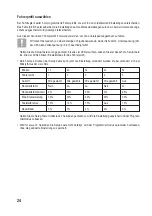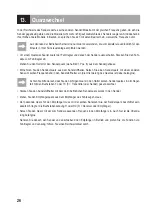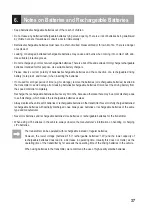
38
7. Charging Rechargeable Batteries
a) Charging the Driving Battery for the Vehicle
• A rechargeable driving battery is not included in the delivery and must be ordered separately. This enables you to
choose whether you want to use a low-cost beginner’s rechargeable battery pack or a high-quality professional
battery pack which has a higher capacity.
• The rechargeable driving battery is delivered uncharged and must be charged. Before the rechargeable driving
battery delivers its maximum power, several complete discharge and charge cycles are necessary.
• Always drive the NiCd driving battery empty, because recharging a „half-full“ NiCd driving battery repeatedly can
cause a so called memory effect. That means that the driving battery loses its capacity; it no longer releases all of its
stored energy and the driving time is decreased.
In case of rechargeable batteries with NiMH technology or LiPo batteries, recharging partially discharged rechargeable
batteries does not cause any problems.
• High-quality rechargeable driving batteries not only have a higher capacity, which allows you to drive your model car
much longer, but also deliver a higher output voltage for extreme situations. This gives the engine more power and
results in better acceleration and higher speed.
• If you are using several driving batteries or rechargeable batteries, purchasing a high-quality charger may be
worthwhile. Such a charger usually has a quick-charging feature.
• Rechargeable batteries heat up during charging/discharging (driving the vehicle). Wait until the rechargeable batteries
have reached room temperature before charging them. The same applies after the charging procedure. Do not use
the rechargeable battery in the vehicle until it has cooled down sufficiently after the charge process.
• Only use a charger suitable for the rechargeable battery type used (LiPo or NiCd/NiMH).
• Remove the driving battery from the vehicle for charging.
b) Charging Rechargeable Batteries in the Transmitter
It is possible that the provided transmitter does not have a charging socket. In this case, remove the
inserted batteries and charge them externally.
If your transmitter has a charging socket, check whether there are actually rechargeable batteries inserted
in the transmitter before connecting the charger. When charging normal (non-rechargeable) batteries,
there is a risk of fire and explosion!
• We do not recommend to charge batteries directly in the transmitter; it is better to charge them outside the transmitter
(using a high-quality charger for individual cells).
• Rechargeable batteries in the transmitter may not be quick-charged, as this damages the transmitter and excessively
heats the cells inside the transmitter. Depending on the batteries used, we recommend a maximum charging current
of 200-300 mA. Please note the label on the charging socket or the type plate of the transmitter.
• Only use a charger designed for 8 AA/mignon cells and the corresponding rechargeable battery type (NiCd, NiMH).
Содержание 23 73 30
Страница 119: ...118 ...
Страница 120: ...119 ...
















































